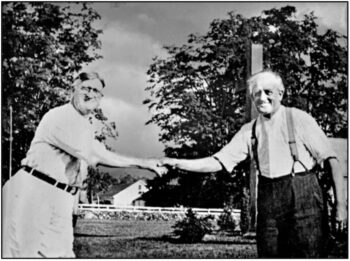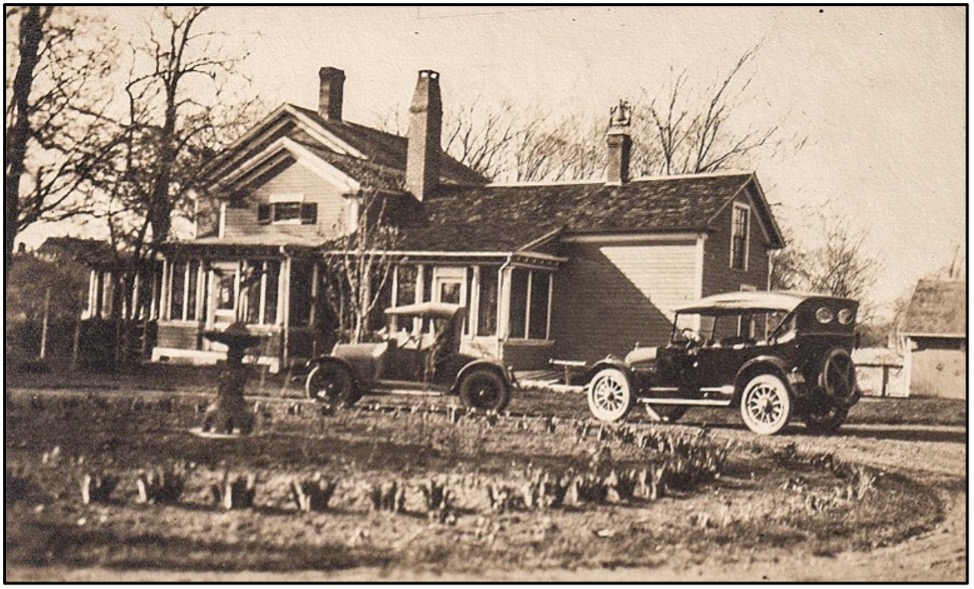About the Park
The Boothe Brothers of Stratford, Connecticut may be the most overlooked duo in American history, despite their amazing contributions to history, the arts, business, architecture, and farming. However, their legacy lives on in an array of odd and fascinating historical buildings & artifacts on display at the thirty-two acre Boothe Memorial Park & Museum. It was here, on the banks of the Housatonic River, that the brothers were born, raised and spent their lives.
David and Stephen Boothe were born in the family’s Homestead within two years of each other, in the aftermath of the American Civil War. No one could have predicted that these sons of a hard-working, simple farmer would far exceed even their family’s past contributions. But, in fact, that’s just what they did. They became wealthy and socially conscious entrepreneurs, realtors, insurance agents, world travelers, inventors and charismatic showmen, who rivaled even neighboring Bridgeport mayor and renowned showman P.T. Barnum for their circus-like exploits.
They led quiet lives until the wave of the Industrial Revolution challenged them to move from a life of farming to one that had so many possibilities. They traveled, started businesses, and beginning in 1929, they initiated a large-scale building program that transformed the former farm into the complex that is now Boothe Memorial Park & Museum. Their eccentric nature and talents led them to build one odd structure after another, resulting in what is regarded as one of the most unique architectural building displays in New England.

Each of the brothers was “eccentric” in his own way. They were a 19th and early 20th Century version of the Odd Couple. David, the older son, was the creative, charming, extrovert who marched in colorful Uncle Sam costumes in local parades, while designing and building many of the curiosities on display today. Stephen loved music, cooking and the arts. He traveled across the globe, to bring back an assortment of exotic artifacts that are found in the Museum today. David and Stephen led colorful and active lives and yet remain, for the most part, unknown to the general public. The good news is that they left a treasure trove of artifacts and records of their family, so that a great deal of their lives can be seen and remembered. They led innovative, creative, and eccentric lives.
When they died in the late 1940’s, their identical wills generously bequeathed all of their land and buildings to the Town of Stratford, to establish a public park for everyone to visit and enjoy as they had during their lifetimes. In their bequest they wrote:
“We have enjoyed picturing in our minds the manner in which it could be laid out and beautified, so that it would be an attractive and restful place to which people could come and enjoy its extensive views, scenic beauty and pleasures, and we hope that the Town of Stratford, where so many generations of our family have lived, will make full and complete use of it with that end in view.”
Boothe Memorial Park & Museum was officially opened to the public in 1955 and it has grown in popularity ever since.
A conspicuous characteristic of the Park is its dual nature: Town recreation and Boothe Museum. The museum aspects are concentrated in the northwest region of the site, around the Homestead. The museum sector contains twenty-eight structures, including outbuildings, which resulted from the building program of the Boothe Brothers. The remainder of the site is given over to passive and semi-active recreation—picnics and play, jogging and walks. The focus of the recreational aspect of the Park is the Coliseum, which is rented by the Town to individuals for a wide variety of uses, and the land to the east between the Main Parking Lot and the river.
The Museum buildings range in date from circa 1840 to 1961. The earliest buildings are in the Greek Revival Style. Later buildings were constructed in the Queen Anne Style, the Shingle Style, and in a highly individualistic eclectic style developed by the Boothe Brothers. A variety of materials are used in the construction of buildings and other structures on the property. Most are of frame construction, although a number of masonry structures are also present. One building, the Technocratic Cathedral, is of an unusual construction using interlocking redwood beams.
The grounds are landscaped with ornamental plantings of deciduous and evergreen trees and shrubs, and feature an American Rose Society-accredited Rose/Wedding Garden, a project of the Friends of Boothe Park. The entire site is listed on the National Register of Historic Places by the U.S. Department of the Interior.

The Park has been an important asset to the Town and State, since it opened. It is used for recreation, picnics, club meetings, weddings, public gatherings, and school outings. There is a children’s playground in the southeast region of the Park. The fascinating and exceptional collection of buildings and artifacts gives Boothe Memorial Park & Museum added importance as a tourist destination and a site with immense potential for historic education and interpretation. The Boothe Collections consist of over 10,000 catalogued artifacts, which are cared for and restored by experienced Friends of Boothe volunteers and other professionals. The artifacts are displayed in several of the Park buildings, which have been converted into museums by the Friends of Boothe Park. The buildings housing the main Boothe Collections include the Boothe Homestead, Carriage Barn, Americana Barn, Clocktower Museum, Blacksmith Shop, and Technocratic Cathedral. Other features include a miniature lighthouse, windmill, trolley station, organ house, outhouse, ice house, and a Merritt Parkway toll booth.
As well as the Museum, other organizations based at Boothe Park include the Putney Chapel, the Stratford Veterans Museum (which is housed in the Boothe Summer Cottage), the Stratford Amateur Radio Club, the Boothe Memorial Railway Society, and the Boothe Memorial Astronomical Society.
Thousands of visitors enjoy the grounds and tour the Museum buildings, each year, including many area school children who participate in an elementary School Program focused on ‘Life on a 19th-Century Farm.’ Today, Boothe Memorial Park & Museum serves as a living tribute to the extraordinary Boothe Brothers.

